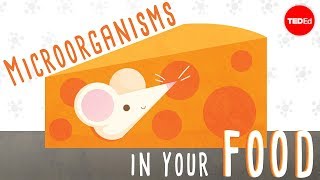(单词翻译:单击)
Where does bread get its fluffiness?
面包为什么松软?
Swiss cheese its holes? And what makes vinegar so sour?
瑞士奶酪为什么有洞?醋为什么是酸的?
These foods may taste completely different,
这些食物的味道可能千差万别,
but all of these phenomena come from tiny organisms chowing down on sugar and belching up some culinary byproducts.
但这些现象都是微生物分解糖分释放出一些美味副产品的结果。
Let's start with yeast. Yeast are single-celled fungi used to make bread, beer, and wine, among other products.
我们先来看看酵母。酵母是单细胞真菌,用于制作面包、啤酒、葡萄酒及许多其他的产品。
Yeast break down carbohydrates, like sugar, to get energy and the molecules they need to function.
酵母分解碳水化合物,例如糖,从而获得其工作所需的分子和能量。
They have two different ways to do this:
他们的工作方式分两种:
the oxygen-dependent, or aerobic, pathway,
氧依赖的,或好氧途径,
and the oxygen-independent, anaerobic pathway, which is also called fermentation.
及非氧依赖的,或厌氧途径,厌氧途径又被称为发酵。
When you bake bread, yeast can use both pathways,
当你烤面包时,酵母可两种途径并用,
but they normally prefer to start with the anaerobic process of fermentation.
不过它们通常会先开始厌氧发酵。
In this process, ethanol is produced in addition to CO2. No, bread isn't alcoholic.
在这个过程中,会产生乙醇和二氧化碳。哦不,面包可不酗酒。
Small amounts of alcohol that are secreted evaporate during baking.
少量酒精在烘焙过程中就蒸发了。
In the aerobic, or oxygen-dependent pathway,
在好氧(氧依赖)途径中,
the yeast consume some of the sugar and produce carbon dioxide gas, or CO2, and water.
酵母分解部分糖,然后产生二氧化碳气体(CO2),以及水。
In both processes, the CO2 accumulates and creates tiny bubbles.
在这两个过程中,二氧化碳积聚形成气泡,
These bubbles get trapped by gluten and create a sponge-like structure that gives the bread its soft texture.
这些气泡被面筋困住就形成了类似海绵的结构,让面包变得松软。
Wine also relies on yeast. But a wine-making set-up keeps the oxygen levels low
葡萄酒的制作也需要酵母。不过制酒装置保持低氧含量,
so that yeast consume sugar using fermentation, the anaerobic pathway.
从而保证酵母通过发酵分解糖分,即厌氧途径。
The process often starts with wild yeasts already hanging out on the grapes.
一开始,都是葡萄本身自带的野生酵母自行发酵。
But to get consistent results, most winemakers also add carefully selected strains of yeast that can tolerate high levels of alcohol.
不过为了统一发酵结果,大多酿酒师都会谨慎挑选加入一些酵母菌株,这些菌株须能忍受高浓度的酒精。
The yeast consume the sugar in the grape juice, and as the sugar level drops, the alcohol level rises.
酵母分解葡萄汁中的糖分,随着糖分减少,酒精便浓度升高。
This doesn't necessarily mean that sweeter wines have less alcohol.
这也不意味着偏甜的葡萄酒酒精浓度就不高。
Different types of grapes start with different amounts of sugar, and sugar can also be added.
葡萄种类不同,所含糖分也不同,而且糖分可以额外添加。

What happens to the carbon dioxide? It just bubbles away through a vent.
那二氧化碳呢?从通风口排出去了。
In carbonated alcoholic beverages, like champagne and beer,
那些碳酸酒精饮料,如香槟和啤酒,
sealed containers are used in primary or secondary fermentation to keep the carbon dioxide in the bottle.
在初次或二次发酵时,将被密封储存,来把二氧化碳留在瓶子里。
Wine also introduces us to our second type of food-producing microorganism: bacteria.
说到葡萄酒,也就说到了要介绍的第二种可制作食品的微生物:细菌。
A special strain of bacteria turns a tart compound in grape juice into softer tasting ones
某种特殊菌株将葡萄汁中某种酸化合物的口味变柔和,
that are responsible for some of the flavors in red wines and chardonnays.
这影响了一些红酒和霞多丽白酒的味道。
Another type of bacteria, called acetic acid bacteria, isn't so desirable in wine, but they have their function, too.
另一种细菌,名为醋酸菌,虽然在葡萄酒中不太受欢迎,但也有其用武之地。
If there's oxygen around, these bacteria convert the ethanol in wine into, well, acetic acid.
若周围有氧气,这些细菌会将葡萄酒中的乙醇转换成醋酸。
Let this process continue and you'll eventually get vinegar.
继续这个过程,你就酿成了醋。
Bacteria are the key for cheese, too. To make cheese, milk is inoculated with bacteria.
细菌也是制作奶酪的关键。要制作奶酪,就要在牛奶中放入细菌。
The bacteria gobble up the lactose, a kind of sugar, and produce lactic acid, along with many other chemicals.
这些细菌很快消耗掉乳糖(一种糖),并且产生乳酸及很多其他的化学成分。
As the milk gets more and more acidic, its proteins start to aggregate and curdle.
奶因此越变越酸,所含的蛋白质开始聚集并凝结。
That's why spoiled milk is clumpy.
这就是为什么坏掉的奶是一块一块的。
Cheesemakers usually add an enzyme called rennet,
奶酪制作者通常会添加一种叫凝乳酶的酶,
naturally found inside of cows, goats, and some other mammals to help this process along.
它自然存在于牛、羊及其他哺乳动物的体内,来帮助发酵。
Eventually, those little curdles turn into bigger curds,
最终,那些小凝块变成大凝乳,
which are pressed to squeeze out the water, and create a firm cheese.
凝乳被挤压从而榨出其中的水,就形成了硬奶酪。
Different strains of bacteria make different kinds of cheese.
不同的菌株用以制作不同的奶酪。
For example, a species of bacteria that emits carbon dioxide is what gives swiss cheese its characteristic holes.
比如某种释放二氧化碳的细菌让瑞士奶酪有了其特有的洞。
Some cheeses, brie and camembert, use another kind of microorganism, too: mold.
有些奶酪,如布里干酪和卡芒贝尔奶酪,还使用另一种微生物:霉菌。
So your kitchen functions as a sort of biotechnology lab manned by microorganisms that culture your cuisine.
这样你的厨房就像一个生物技术实验室一样运作,利用微生物来培养美食。
Yogurt, soy sauce, sour cream, sauerkraut, kefir, kimchi, kombucha, cheddar, challah, pita, and naan.
酸奶、酱油、酸奶油、德国泡菜、克菲尔酸乳酒、辣白菜、康普茶、切达干酪、哈拉面包、皮塔饼、馕饼。
But maybe not all at the same dinner.
不过不要一口气全吃了哟。


